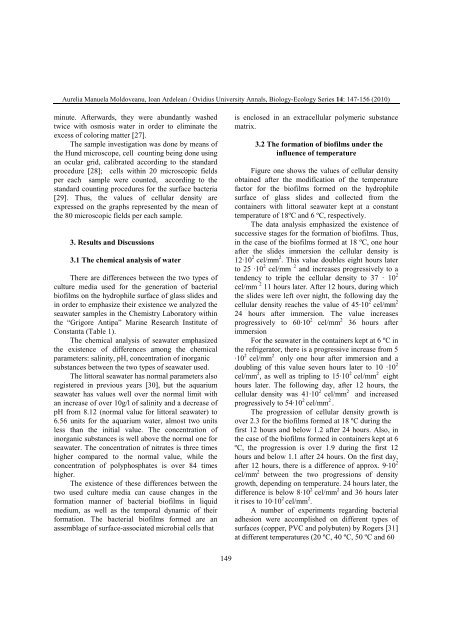VOLUM OMAGIAL - Facultatea de Ştiinţe ale Naturii şi Ştiinţe Agricole
VOLUM OMAGIAL - Facultatea de Ştiinţe ale Naturii şi Ştiinţe Agricole
VOLUM OMAGIAL - Facultatea de Ştiinţe ale Naturii şi Ştiinţe Agricole
You also want an ePaper? Increase the reach of your titles
YUMPU automatically turns print PDFs into web optimized ePapers that Google loves.
Aurelia Manuela Moldoveanu, Ioan Ar<strong>de</strong>lean / Ovidius University Annals, Biology-Ecology Series 14: 147-156 (2010)<br />
minute. Afterwards, they were abundantly washed<br />
twice with osmosis water in or<strong>de</strong>r to eliminate the<br />
excess of coloring matter [27].<br />
The sample investigation was done by means of<br />
the Hund microscope, cell counting being done using<br />
an ocular grid, calibrated according to the standard<br />
procedure [28]; cells within 20 microscopic fields<br />
per each sample were counted, according to the<br />
standard counting procedures for the surface bacteria<br />
[29]. Thus, the values of cellular <strong>de</strong>nsity are<br />
expressed on the graphs represented by the mean of<br />
the 80 microscopic fields per each sample.<br />
3. Results and Discussions<br />
3.1 The chemical analysis of water<br />
There are differences between the two types of<br />
culture media used for the generation of bacterial<br />
biofilms on the hydrophile surface of glass sli<strong>de</strong>s and<br />
in or<strong>de</strong>r to emphasize their existence we analyzed the<br />
seawater samples in the Chemistry Laboratory within<br />
the “Grigore Antipa” Marine Research Institute of<br />
Constanta (Table 1).<br />
The chemical analysis of seawater emphasized<br />
the existence of differences among the chemical<br />
parameters: salinity, pH, concentration of inorganic<br />
substances between the two types of seawater used.<br />
The littoral seawater has normal parameters also<br />
registered in previous years [30], but the aquarium<br />
seawater has values well over the normal limit with<br />
an increase of over 10g/l of salinity and a <strong>de</strong>crease of<br />
pH from 8.12 (normal value for littoral seawater) to<br />
6.56 units for the aquarium water, almost two units<br />
less than the initial value. The concentration of<br />
inorganic substances is well above the normal one for<br />
seawater. The concentration of nitrates is three times<br />
higher compared to the normal value, while the<br />
concentration of polyphosphates is over 84 times<br />
higher.<br />
The existence of these differences between the<br />
two used culture media can cause changes in the<br />
formation manner of bacterial biofilms in liquid<br />
medium, as well as the temporal dynamic of their<br />
formation. The bacterial biofilms formed are an<br />
assemblage of surface-associated microbial cells that<br />
149<br />
is enclosed in an extracellular polymeric substance<br />
matrix.<br />
3.2 The formation of biofilms un<strong>de</strong>r the<br />
influence of temperature<br />
Figure one shows the values of cellular <strong>de</strong>nsity<br />
obtained after the modification of the temperature<br />
factor for the biofilms formed on the hydrophile<br />
surface of glass sli<strong>de</strong>s and collected from the<br />
containers with littoral seawater kept at a constant<br />
temperature of 18ºC and 6 ºC, respectively.<br />
The data analysis emphasized the existence of<br />
successive stages for the formation of biofilms. Thus,<br />
in the case of the biofilms formed at 18 ºC, one hour<br />
after the sli<strong>de</strong>s immersion the cellular <strong>de</strong>nsity is<br />
12∙10 2 cel/mm 2 . This value doubles eight hours later<br />
to 25 ∙10 2 cel/mm 2 and increases progressively to a<br />
ten<strong>de</strong>ncy to triple the cellular <strong>de</strong>nsity to 37 ∙ 10 2<br />
cel/mm 2 11 hours later. After 12 hours, during which<br />
the sli<strong>de</strong>s were left over night, the following day the<br />
cellular <strong>de</strong>nsity reaches the value of 45∙10 2 cel/mm 2<br />
24 hours after immersion. The value increases<br />
progressively to 60∙10 2 cel/mm 2 36 hours after<br />
immersion<br />
For the seawater in the containers kept at 6 ºC in<br />
the refrigerator, there is a progressive increase from 5<br />
∙10 2 cel/mm 2 only one hour after immersion and a<br />
doubling of this value seven hours later to 10 ∙10 2<br />
cel/mm 2 , as well as tripling to 15∙10 2 cel/mm 2 eight<br />
hours later. The following day, after 12 hours, the<br />
cellular <strong>de</strong>nsity was 41∙10 2 cel/mm 2 and increased<br />
progressively to 54∙10 2 cel/mm 2 .<br />
The progression of cellular <strong>de</strong>nsity growth is<br />
over 2.3 for the biofilms formed at 18 ºC during the<br />
first 12 hours and below 1.2 after 24 hours. Also, in<br />
the case of the biofilms formed in containers kept at 6<br />
ºC, the progression is over 1.9 during the first 12<br />
hours and below 1.1 after 24 hours. On the first day,<br />
after 12 hours, there is a difference of approx. 9∙10 2<br />
cel/mm 2 between the two progressions of <strong>de</strong>nsity<br />
growth, <strong>de</strong>pending on temperature. 24 hours later, the<br />
difference is below 8∙10 2 cel/mm 2 and 36 hours later<br />
it rises to 10∙10 2 cel/mm 2 .<br />
A number of experiments regarding bacterial<br />
adhesion were accomplished on different types of<br />
surfaces (copper, PVC and polybuten) by Rogers [31]<br />
at different temperatures (20 ºC, 40 ºC, 50 ºC and 60





